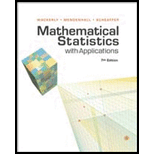
Concept explainers
In Exercise 5.38, we determined that the joint density
In this case, the random variable Y1 − Y2 measures the amount of stock remaining at the end of the week, a quantity of great importance to the supplier. Find E(Y1 − Y2).
5.38 Let Y1 denote the weight (in tons) of a bulk item stocked by a supplier at the beginning of a week and suppose that Y1 has a uniform distribution over the interval 0 ≤ y1 ≤ 1. Let Y2 denote the amount (by weight) of this item sold by the supplier during the week and suppose that Y2 has a uniform distribution over the interval 0 ≤ y2 ≤ y1, where y1 is a specific value of Y1.
- a Find the joint density function for Y1 and Y2.
- b If the supplier stocks a half-ton of the item, what is the probability that she sells more than a quarter-ton?
- c If it is known that the supplier sold a quarter-ton of the item, what is the probability that she had stocked more than a half-ton?
Want to see the full answer?
Check out a sample textbook solution
Chapter 5 Solutions
Mathematical Statistics with Applications
- A soda can has a volume of 25 cubic inches. Let x denote its radius and h its height, both in inches. a. Using the fact that the volume of the can is 25 cubic inches, express h in terms of x. b. Express the total surface area S of the can in terms of x.arrow_forwardA soda can is made from 40 square inches of aluminum. Let x denote the radius of the top of the can, and let h denote the height, both in inches. a. Express the total surface area S of the can, using x and h. Note: The total surface area is the area of the top plus the area of the bottom plus the area of the cylinder. b. Using the fact that the total area is 40 square inches, express h in terms of x. c. Express the volume V of the can in terms of x.arrow_forwardPlzarrow_forward
- Please answer ALL parts (a, b, & c) completely.arrow_forwardConsider the given closed rectangular box with dimensions x cm, v cm and z cm. Assume that x is increasing at the rate of 20 cm per hour and v is decreasing at a rate of 15 cm per hour and z is decreasing at a rate of 10 cm per hour. At what rate is the box's surface area is changing when x is 20 cm, y is 10 cm, z is 100 cm? |군arrow_forwardThe boundary of a lamina consists of the semicircles y = √16x² and y = √36x² together with the portions of the x-axis that join them. Find the center of mass of the lamina if the density at any point is inversely proportional to its distance from the origin. (x, 7) = ( Xarrow_forward
- Gasoline is to be stocked in a bulk tank once at the beginning of each week and then sold to individual customers. The joint density of Y,, the proportion of the capacity of the tank that is stocked at the beginning of the week, and Y,, the proportion of the capacity sold during the week, is given by S3y,, 0s y2 s Y1 < 1, lo, f(y,, Y2) = elsewhere. (a) Find the marginal density function for Y,. , where (b) For what values of y, is the conditional density f(y, ly,) defined? (c) What is the probability that more than half a tank is sold given that six-sevenths of a tank is stocked? (Enter your probability as a fraction.)arrow_forward(b) insects per cubic foot. Describe the set of all points at which the insect density is 20 (c) shape of the level surfaces? Describe the level surfaces of the function p. Identify the generalarrow_forward
 Functions and Change: A Modeling Approach to Coll...AlgebraISBN:9781337111348Author:Bruce Crauder, Benny Evans, Alan NoellPublisher:Cengage Learning
Functions and Change: A Modeling Approach to Coll...AlgebraISBN:9781337111348Author:Bruce Crauder, Benny Evans, Alan NoellPublisher:Cengage Learning
